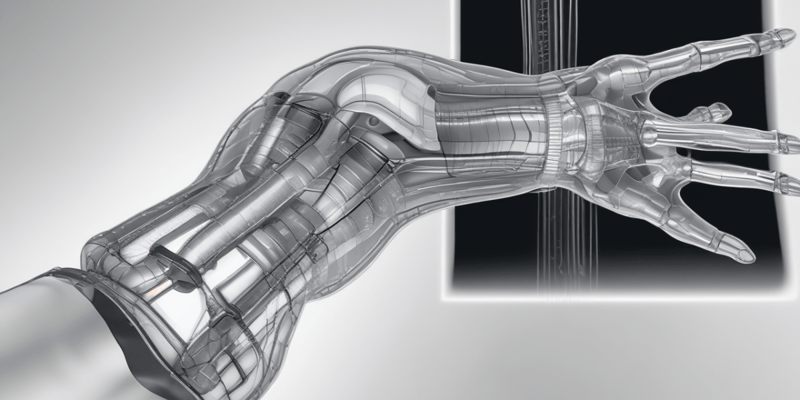Podcast
Questions and Answers
What term includes both computed radiography (CR) and direct radiography (DR)?
What term includes both computed radiography (CR) and direct radiography (DR)?
When did digital radiography enter the medical field?
When did digital radiography enter the medical field?
What company introduced the first CR systems in the US?
What company introduced the first CR systems in the US?
What is the main component of CR imaging plates?
What is the main component of CR imaging plates?
Signup and view all the answers
What is the purpose of europium doping in CR imaging plates?
What is the purpose of europium doping in CR imaging plates?
Signup and view all the answers
What is the function of the CR reader?
What is the function of the CR reader?
Signup and view all the answers
What is the outcome of exposing a CR imaging plate to the exit beam?
What is the outcome of exposing a CR imaging plate to the exit beam?
Signup and view all the answers
What is the purpose of the CR workstation?
What is the purpose of the CR workstation?
Signup and view all the answers
What type of laser beam is used to scan the CR imaging plate?
What type of laser beam is used to scan the CR imaging plate?
Signup and view all the answers
What is the purpose of exposing the CR plate to a bright white light after use?
What is the purpose of exposing the CR plate to a bright white light after use?
Signup and view all the answers
What is the result of incomplete clearing of the CR plate?
What is the result of incomplete clearing of the CR plate?
Signup and view all the answers
What is the function of the Analog-to-Digital Converter (ADC) in CR processing?
What is the function of the Analog-to-Digital Converter (ADC) in CR processing?
Signup and view all the answers
What is the effect of not recognizing the collimated borders during image data analysis?
What is the effect of not recognizing the collimated borders during image data analysis?
Signup and view all the answers
What is the purpose of using a fiber optic light guide in CR processing?
What is the purpose of using a fiber optic light guide in CR processing?
Signup and view all the answers
What is the effect of scatter radiation on the CR plate?
What is the effect of scatter radiation on the CR plate?
Signup and view all the answers
What is the purpose of the workstation in CR processing?
What is the purpose of the workstation in CR processing?
Signup and view all the answers
Why should CR plates be erased after 48 hours of non-use?
Why should CR plates be erased after 48 hours of non-use?
Signup and view all the answers
What is the process called when the laser stimulates the movement of trapped electrons back to their original position?
What is the process called when the laser stimulates the movement of trapped electrons back to their original position?
Signup and view all the answers
Study Notes
Digital Radiography
- Digital radiography includes both computed radiography (CR) and direct radiography (DR).
- Digital radiography entered the medical field around the late 1980s and early 1990s.
Computed Radiography (CR)
- The first CR systems in the US were introduced by Fuji Photo Film.
- The main component of CR imaging plates is Photostimulable Phosphor (PSP).
- Europium doping enhances the luminescent properties of the imaging plates, improving image quality.
CR Reader and Imaging Process
- The CR reader scans the imaging plate to retrieve stored data by stimulating the phosphors with a laser beam.
- Exposing a CR imaging plate to the exit beam captures an image by converting x-rays to electron energy within the phosphor.
- The CR workstation processes the data retrieved from the CR reader for viewing and analysis.
Laser and Light Exposure
- A solid-state laser beam is utilized to scan the CR imaging plate, ensuring precise reading of the stored image.
- Exposing the CR plate to bright white light after use resets the phosphor and eliminates residual image data.
Image Processing and Artifacts
- Incomplete clearing of the CR plate can lead to residual ghost images that affect diagnostic accuracy.
- The Analog-to-Digital Converter (ADC) in CR processing converts the analog signal from the imaging plate to a digital format for further processing.
- Not recognizing the collimated borders during image data analysis may result in inaccurate measurements and diagnostics.
Fiber Optic and Radiation Effects
- A fiber optic light guide in CR processing directs light efficiently from the imaging plate to the reader, enhancing image capture.
- Scatter radiation can negatively impact the quality of the CR plate, leading to noise and artifacts in the images.
Workstation Functions
- The workstation in CR processing is essential for image processing, storage, and retrieval, facilitating efficient diagnostics.
- CR plates should be erased after 48 hours of non-use to prevent unwanted retention of data and maintain image clarity.
Electron Movement
- The process whereby the laser stimulates trapped electrons to return to their original position is known as photostimulated luminescence.
Studying That Suits You
Use AI to generate personalized quizzes and flashcards to suit your learning preferences.
Related Documents
Description
Learn about the history and development of digital radiography, including computed radiography (CR) and direct radiography (DR). Discover how digital radiography entered the medical field and how CR systems evolved over time.




